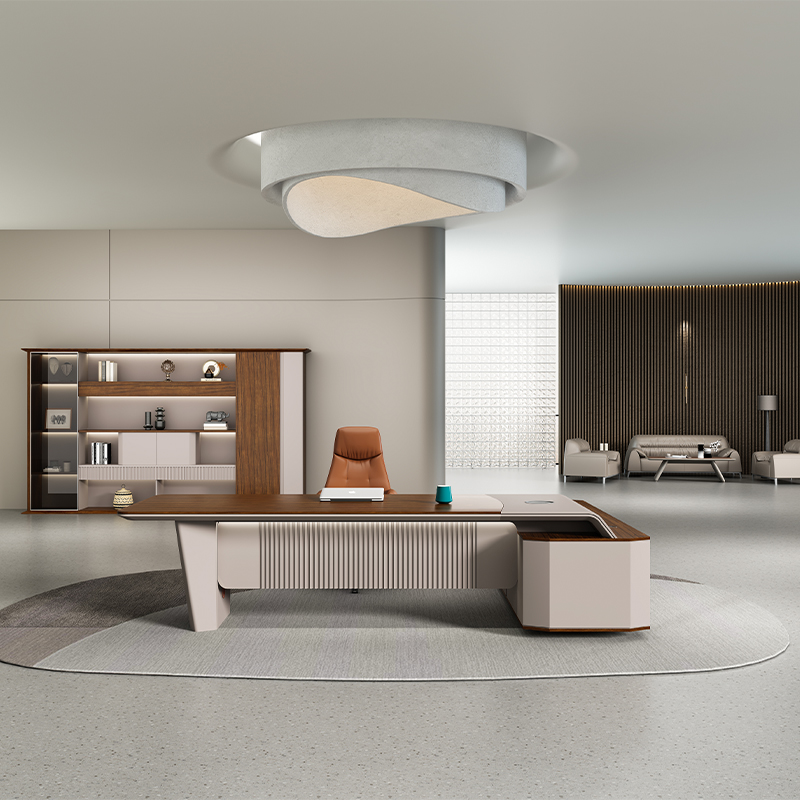
October 15,2025
admin
Office tables are the core furniture of any workspace. The material of the table not only influences its appearance and style but also impacts its durability and user experience. With the continuous innovation in office furniture design, the selection of office table materials has become increasingly diverse. From traditional wooden surfaces to modern metal and glass materials, each type offers unique characteristics that cater to different office needs and styles. This article will provide a comprehensive analysis of common office table materials, highlighting their advantages and disadvantages, to help you choose the most suitable option for yourself and your company.
Solid Wood Office Tables
Solid wood is one of the most traditional and classic office table materials. With its natural wood grain and warm tones, solid wood office tables often convey a sense of stability and comfort. Common solid wood materials include oak, walnut, and cherry wood.
Advantages: Aesthetic appeal, natural look, and durability. Solid wood tables exude a sense of elegance and a natural atmosphere.
Disadvantages: Higher cost, requires regular maintenance, and is susceptible to temperature and humidity changes, which can cause cracking or warping.
Composite Wood Office Tables
Composite wood materials are made by bonding different wood fibers together with adhesives, making them more economical than solid wood. Common composite wood types include Medium-Density Fiberboard (MDF) and particleboard.
Advantages: Lower cost, less prone to deformation, and the surface can be treated in various ways, such as wood veneer or painting, offering diverse appearances.
Disadvantages: Less durable than solid wood, lighter in weight, and may experience surface wear or adhesive degradation over time.

Steel Office Tables
Steel office tables are typically made from cold-rolled steel sheets, with surfaces treated through spraying or baking processes. They have a rigid and minimalist appearance, making them ideal for industrial or modern office spaces.
Advantages: Sturdy and durable, high load-bearing capacity, impact-resistant, wear-resistant, and easy to clean. Ideal for heavy-duty office tables such as design workstations or technical desks.
Disadvantages: Aesthetically cold and lacks warmth, and the surface can easily show scratches or fingerprints.
Aluminum Alloy Office Tables
Aluminum alloy, a lightweight metal material, is widely used in modern office table designs. It is often used for table legs or frames and paired with glass or wooden surfaces, creating a stylish and minimalist look.
Advantages: Lightweight, durable, corrosion-resistant, and strong in design. Suitable for modern minimalist office environments.
Disadvantages: The load-bearing capacity of aluminum alloy is not as strong as steel, so it needs to be paired with a sturdy tabletop material.

Tempered Glass Office Tables
Tempered glass is a safety glass that has undergone special treatment to enhance its impact resistance. Glass tabletops are usually paired with metal or wooden legs, giving an overall modern and transparent feel.
Advantages: Visually transparent, stylish, and suitable for those who want to create a modern and spacious office environment. Tempered glass is scratch-resistant, heat-resistant, and easy to clean.
Disadvantages: Glass is fragile, and although tempered glass is safer, the overall tabletop remains relatively delicate. It also easily shows fingerprints or smudges, requiring frequent cleaning.

Marble or Artificial Stone Office Tables
Marble or artificial stone office tables are usually used in high-end office spaces, such as executive offices or reception areas. Marble has unique natural textures and a solid feel.
Advantages: High-end appearance, rich texture, scratch-resistant, heat-resistant, easy to clean, and the surface is very sturdy and durable.
Disadvantages: High cost, heavy weight, and not easy to move. Artificial stone has better processing performance and a wider range of color choices compared to natural marble.

Mixed Material Office Tables
Mixed material office tables are designed with a combination of various materials. For example, a wooden tabletop with metal legs or a glass tabletop with a wooden or metal frame. This design not only combines the advantages of different materials but also meets various office needs.
Advantages: High design flexibility, capable of integrating the advantages of multiple materials such as the warmth of wood, the sturdiness of metal, and the transparency of glass. Suitable for diverse office environments.
Disadvantages: Higher design and manufacturing costs, and may require customized services.

Choosing the right office table material is not just about aesthetics; it's also about enhancing the work experience and the overall atmosphere of the office environment. From the classic warmth of wood to the modern simplicity of metal and the stylish transparency of glass, each material has its unique charm and functional characteristics. When selecting an office table, it's advisable to consider usage needs, office environment, and personal preferences to create a workspace that is both beautiful and practical for yourself and your team. We hope this article provides some reference and inspiration for choosing the right office table material. Choose Ekintop Furniture, and we will provide you with the best products and services.

